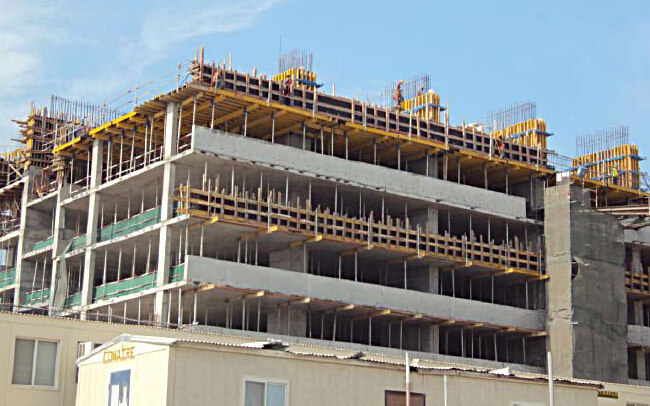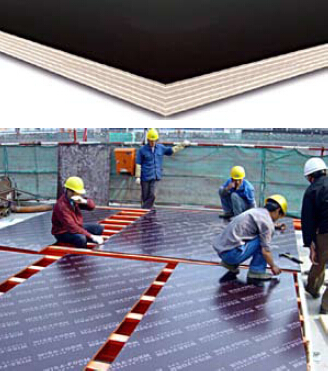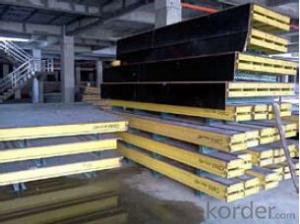Plywood-Formwork system for formwork and scaffolding
- Loading Port:
- Tianjin
- Payment Terms:
- TT OR LC
- Min Order Qty:
- 50 m²
- Supply Capability:
- 1000 m²/month
OKorder Service Pledge
Quality Product, Order Online Tracking, Timely Delivery
OKorder Financial Service
Credit Rating, Credit Services, Credit Purchasing
You Might Also Like
Plywood --- make perfect concrete surface
WISA-Form Birch is a coated special plywood using in the formwork systems where high
requirements are set on the concrete surface and the times of reuses.
With CNBM timber beam & WISA plywood, the formwork is low weight but high load capacity, it is
widely used in construction.
Characteristics:
◆ Component with high standardization.
◆ Assembling in site, flexible application.
◆ Light weight, easy transportation and storage.


- Q:How does steel formwork handle different concrete surface treatments?
- Steel formwork is known for its versatility and durability in handling different concrete surface treatments. Due to its strong and rigid structure, steel formwork can effectively withstand the pressure and weight of different concrete surface treatments without deforming or collapsing. Steel formwork is commonly used in construction projects that require various surface treatments, such as smooth, textured, or patterned finishes. The steel panels and frames provide a stable and rigid surface, ensuring that the concrete is poured and cured evenly. This helps to achieve a high-quality and consistent finish. Additionally, steel formwork can easily accommodate different types of surface treatments. For instance, if a project requires a smooth finish, the steel formwork can be polished or coated with a release agent to create a smooth surface. If a project requires a textured or patterned finish, the steel formwork can be specially designed or modified to incorporate the desired texture or pattern. This flexibility allows for creativity and customization in achieving the desired aesthetics. Furthermore, steel formwork can be reused multiple times, making it cost-effective and environmentally friendly. This means that it can handle different concrete surface treatments in various projects, providing consistent and reliable results each time. In summary, steel formwork is an excellent choice for handling different concrete surface treatments due to its strength, durability, and versatility. It can withstand the pressure and weight of various finishes, accommodate different types of surface treatments, and be reused multiple times, making it a reliable and cost-effective option in construction projects.
- Q:Can steel formwork be used for bridge piers?
- Yes, steel formwork can be used for bridge piers. Steel formwork is a versatile and durable option that is suitable for constructing various types of structures, including bridge piers. It offers numerous advantages such as high strength, ease of assembly and disassembly, and flexibility in design. Steel formwork allows for precise shaping and reinforcement of the bridge piers, ensuring structural integrity and stability. Additionally, steel formwork can withstand the high loads and pressures exerted by the bridge piers during their lifespan. Therefore, steel formwork is a reliable and commonly used choice for constructing bridge piers.
- Q:Are there any safety precautions to consider when using steel formwork?
- Yes, there are several safety precautions to consider when using steel formwork. 1. Proper training: It is essential that all workers using steel formwork receive proper training on the correct handling and assembly procedures. This includes understanding the safe load capacity, proper installation techniques, and dismantling processes. 2. Inspection and maintenance: Regular inspection and maintenance of the steel formwork is crucial to ensure its structural integrity. Any signs of damage, such as cracks, bent parts, or loose connections, should be immediately addressed and repaired. 3. Personal protective equipment (PPE): All workers involved in the steel formwork operations should wear appropriate PPE, including helmets, safety goggles, gloves, and steel-toe boots. This will protect them from potential hazards, such as falling objects, sharp edges, or accidental contact with the formwork. 4. Secure and stable platform: It is important to provide a secure and stable platform for workers to access and work on the steel formwork. This may involve using scaffolding, ladders, or elevated work platforms that are properly secured and meet safety standards. 5. Fall protection: Implementing fall protection measures is crucial when working at heights. This may include installing guardrails, safety nets, or personal fall arrest systems to prevent falls and protect workers from serious injuries. 6. Material handling: Proper lifting techniques should be followed when handling steel formwork components to prevent strain or muscle injuries. The use of mechanical lifting equipment, such as cranes or forklifts, can also help minimize the risk of accidents. 7. Communication and coordination: Clear communication and coordination among workers involved in the steel formwork operations is vital to ensure everyone's safety. This includes establishing a clear chain of command, using hand signals or radios for communication, and conducting regular safety meetings to address any concerns or issues. By following these safety precautions, the risk of accidents, injuries, and damage can be significantly reduced when using steel formwork.
- Q:How does steel formwork affect the overall project cost?
- The overall project cost can be significantly affected by steel formwork. Comparatively, steel formwork is generally more expensive than alternatives like wood or aluminum. Nevertheless, there are various factors to consider when assessing the cost-effectiveness of using steel formwork. To begin with, the durability and longevity of steel formwork are well-known. Unlike wood, steel formwork can be reused multiple times, resulting in long-term cost savings. It requires less maintenance and repairs, which reduces the need for frequent replacements. This is particularly advantageous for projects involving repetitive use of formwork. Furthermore, steel formwork provides superior quality and precision in terms of concrete finishing. It offers a smoother surface and accurate dimensions, reducing the necessity for additional finishing work. Consequently, both time and money can be saved during the construction process. Additionally, steel formwork allows for faster construction compared to other types of formwork. It can be assembled and dismantled quickly, leading to faster turnaround times. This can positively impact the overall project schedule and potentially reduce labor costs. Moreover, steel formwork is more resistant to factors such as weather conditions, high pressure, and vibrations. This improves the structural integrity of the concrete, reducing the risk of defects and the need for rework. By minimizing the need for corrective actions, steel formwork can help control project costs. Nevertheless, it is important to note that the cost of steel formwork can vary depending on the size, complexity, and duration of the project. For smaller projects with limited use of formwork, the cost difference between steel and other materials may not be significant. In such cases, alternative formwork options may be more cost-effective. In conclusion, although steel formwork may have a higher upfront cost compared to other materials, its durability, precision, speed, and long-term reusability can result in cost savings throughout the project. It is crucial to carefully evaluate the specific requirements and circumstances of each project to determine the most cost-effective formwork solution.
- Q:Can steel formwork be used in seismic areas?
- Yes, steel formwork can be used in seismic areas. Steel is a strong and durable material that can withstand the forces generated during an earthquake. Additionally, steel formwork provides a stable and rigid structure, which is important in seismic areas to ensure the safety and stability of the construction.
- Q:Are there any environmental benefits to using steel formwork?
- Yes, there are several environmental benefits to using steel formwork. Firstly, steel formwork is reusable, which reduces the need for continuous production of new formwork materials, thereby reducing the consumption of natural resources. Secondly, steel formwork is highly durable and can withstand repeated use, reducing the overall waste generated from construction projects. Lastly, steel is a recyclable material, so at the end of its life cycle, it can be recycled and used for other purposes, reducing the amount of waste sent to landfills. Overall, using steel formwork helps minimize environmental impact and promotes sustainability in construction practices.
- Q:What are the common safety precautions when working with steel formwork in high winds?
- When working with steel formwork in high winds, there are several common safety precautions that should be followed to ensure the safety of workers and the integrity of the formwork. 1. Secure the formwork: It is essential to properly secure the steel formwork to prevent it from being blown away by strong winds. This can be achieved by using appropriate anchoring methods such as tie-downs, braces, or clamps. Adequate bracing should be installed at regular intervals to provide additional stability. 2. Regular inspections: Regular inspections of the formwork should be conducted before, during, and after high wind events. This includes checking for any signs of damage or weakness in the formwork structure, loose connections, or compromised anchoring. Any issues identified should be addressed promptly to prevent accidents or further damage. 3. Reinforce the formwork: In areas with high wind activity, it may be necessary to reinforce the steel formwork to withstand the stronger forces. This can be done by adding additional support beams, cross-bracing, or wind-resistant features to the structure. The reinforcement should be designed and implemented by a qualified engineer to ensure its effectiveness. 4. Provide personal protective equipment (PPE): Workers should be provided with appropriate personal protective equipment to protect them from potential hazards during high wind conditions. This may include safety helmets, goggles, gloves, and high-visibility clothing to enhance visibility for other workers and equipment operators. 5. Monitor weather conditions: Regular monitoring of weather conditions is crucial when working with steel formwork in high winds. If there are predictions or signs of strong winds, work should be temporarily suspended until the wind speeds decrease to safe levels. It is important to have a reliable weather monitoring system in place to stay informed about changing weather conditions. 6. Training and communication: All workers involved in working with steel formwork should receive proper training on the safety precautions and procedures to follow during high wind situations. Clear communication channels should be established to ensure that workers are aware of any changes in weather conditions or safety protocols. By following these common safety precautions, the risks associated with working with steel formwork in high winds can be minimized, ensuring the well-being of workers and the successful completion of the construction project.
- Q:Can steel formwork be used for both residential and industrial projects?
- Steel formwork is applicable to both residential and industrial projects, offering durability and robustness to withstand heavy loads and provide optimal support for concrete structures. Its flexibility allows for easy customization, making it suitable for various construction endeavors, including residential buildings and industrial facilities. Moreover, its strength and durability render it suitable for projects of all sizes and scopes, whether small-scale residential construction or large-scale industrial endeavors. Furthermore, steel formwork presents numerous advantages, including high reusability, low maintenance requirements, and expedited construction processes when compared to traditional formwork systems. Consequently, steel formwork emerges as a dependable and efficient choice for a wide array of construction projects, regardless of their scale or purpose.
- Q:What are the safety considerations when working with steel formwork?
- When working with steel formwork, there are several safety considerations that should be taken into account to ensure the well-being of workers and the overall success of the project. First and foremost, it is important to provide proper training to all workers who will be involved in handling and installing steel formwork. This training should include instruction on how to safely handle heavy steel panels, as well as how to correctly assemble and dismantle the formwork system. Workers should also be educated on the potential hazards associated with steel formwork, such as the risk of falling objects or pinch points between panels, and how to mitigate these risks. Another important safety consideration is the use of appropriate personal protective equipment (PPE). Workers should be provided with and required to wear PPE such as hard hats, safety glasses, steel-toed boots, and gloves to protect themselves from potential hazards. It is also crucial to ensure that the PPE is in good condition and properly fitted to each worker. Proper planning and organization are key to maintaining safety on a steel formwork site. This includes conducting thorough risk assessments before starting any work, identifying potential hazards, and implementing control measures to minimize risks. It is important to establish designated walkways and clear access routes to prevent tripping hazards and ensure safe movement around the site. Regular inspections of the steel formwork system should be conducted to identify any signs of damage or deterioration. Any damaged or defective components should be promptly repaired or replaced to maintain the structural integrity and safety of the formwork. Lastly, communication and coordination among workers are essential for a safe working environment. Clear communication channels and procedures should be established to ensure that everyone is aware of potential hazards and can promptly report any safety concerns. By prioritizing training, providing proper PPE, planning and organizing the work site, conducting regular inspections, and promoting effective communication, the safety considerations when working with steel formwork can be effectively addressed, reducing the risk of accidents and injuries.
- Q:What are the different types of accessories available for steel formwork?
- Steel formwork offers a range of accessories designed to improve the efficiency and effectiveness of the system. Several common types of accessories include: 1. Clamps - These securely connect formwork panels, providing stability and preventing movement during concrete pouring. 2. Wedges - These level and align the panels by inserting them between the panels and tightening for a secure fit. 3. Ties - Made of steel, these secure formwork panels to the structure by inserting them through panel holes and anchoring them. 4. Connectors - These join panels at corners or junctions, maintaining the formwork system's structural integrity. 5. Spacers - These maintain a specific distance between panels, ensuring the desired concrete thickness. 6. Brackets - These support formwork panels during construction, preventing sagging or bending. 7. Release agents - Applied to panels before pouring concrete, these prevent adhesion, allowing for easy removal once the concrete sets. 8. Handles - These facilitate handling and positioning of panels, providing a secure grip for proper placement. 9. Chamfers - These create beveled edges on concrete, attached to panels for a finished look. 10. Accessories for special applications - Specialized accessories exist for curved structures, columns, and beams. These examples highlight the range of accessories available for steel formwork. The choice of accessories depends on project requirements and desired outcomes. Selecting the appropriate accessories is crucial for a successful and efficient formwork system.
1. Manufacturer Overview |
|
|---|---|
| Location | |
| Year Established | |
| Annual Output Value | |
| Main Markets | |
| Company Certifications | |
2. Manufacturer Certificates |
|
|---|---|
| a) Certification Name | |
| Range | |
| Reference | |
| Validity Period | |
3. Manufacturer Capability |
|
|---|---|
| a)Trade Capacity | |
| Nearest Port | |
| Export Percentage | |
| No.of Employees in Trade Department | |
| Language Spoken: | |
| b)Factory Information | |
| Factory Size: | |
| No. of Production Lines | |
| Contract Manufacturing | |
| Product Price Range | |
Send your message to us
Plywood-Formwork system for formwork and scaffolding
- Loading Port:
- Tianjin
- Payment Terms:
- TT OR LC
- Min Order Qty:
- 50 m²
- Supply Capability:
- 1000 m²/month
OKorder Service Pledge
Quality Product, Order Online Tracking, Timely Delivery
OKorder Financial Service
Credit Rating, Credit Services, Credit Purchasing
Similar products
New products
Hot products
Related keywords
























